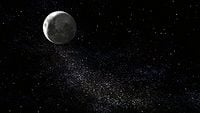Natural satellite: Difference between revisions
From Halopedia, the Halo wiki
No edit summary |
Forerunner (talk | contribs) (this page is not a moon, meerly telling what one is and should be sperated in the category) |
||
| Line 10: | Line 10: | ||
The Jackal homeworld, [[Eayn]], is also a moon orbiting the gas giant [[Chu'ot]]. | The Jackal homeworld, [[Eayn]], is also a moon orbiting the gas giant [[Chu'ot]]. | ||
[[Category:Moons]] | [[Category:Moons| ]] | ||
Revision as of 20:10, January 24, 2009
Template:Ratings Template:SeeWikipedia
A moon is a celestial body that orbits a planet or smaller body, which is called the primary. It is, in more technical terms, a natural satellite.
The large gas giants of Sol have extensive systems of moons, including half a dozen comparable in size to Earth's moon: the four Galilean moons, Saturn's Titan, and Neptune's Triton. Saturn has an additional six mid-sized moons massive enough to have achieved hydrostatic equilibrium, and Uranus has five. Jupiter has more than sixty moons, of which only four are explored. Those moons are called Jovian Moons. Of the inner planets, Mercury and Venus have no moons at all; Earth has one large moon, Luna, and Mars has two tiny moons, Phobos and Deimos.
The Jackal homeworld, Eayn, is also a moon orbiting the gas giant Chu'ot.
